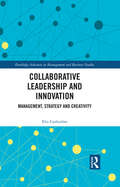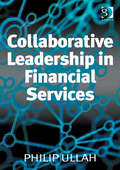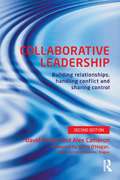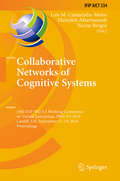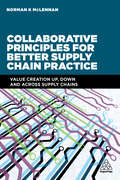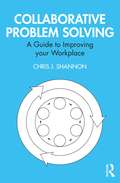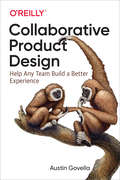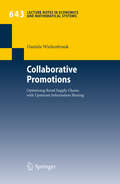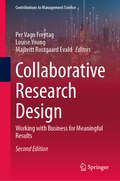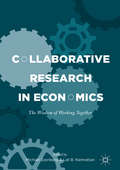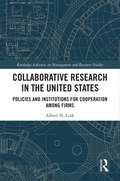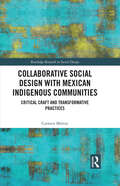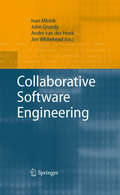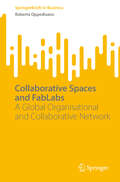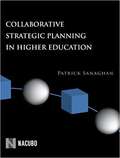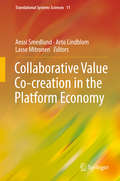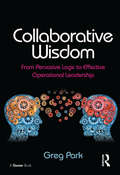- Table View
- List View
Collaborative Leadership and Innovation: Management, Strategy and Creativity (Routledge Advances in Management and Business Studies)
by Elis CarlströmOriginal ideas start in a person´s mind, but the environment where they operate is crucial for the capture and development of these ideas. Equally important is the interaction with others in developing and evaluating ideas, as a brilliant idea only influences the world if it is put into use. This book hopes to inspire the team leader, innovation manager or research group leader. It deals with the delicate balance of managing and controlling intellectual property in a collaborative environment. Insights on how new inventions can be evaluated are offered. Following the whole cycle of innovation from a creative idea to where a product or service can be put on the market, examples illustrate how an innovative environment can be created and maintained. Strategies and solutions based on the science of team development are presented and leadership models for the different phases of group development are provided. The book will be of interest to researchers, academics, product developers, entrepreneurs, and advanced students in the fields of technology and innovation management and entrepreneurship and small business management but also for leadership.
Collaborative Leadership in Financial Services: (special Edition For The Author. Not For Sale To The General Public)
by Philip UllahToday's leader needs to be equipped with the tools and skills to find an effective way to collaborate with others. Global organizations today are highly complex, involving multiple parties, offshore operations, and matrix management structures. Leaders can only successfully deliver their strategic goals if they have the ability to build collaboration across the silos these create. Collaborative Leadership in Financial Services is a practical guide which focuses on technologists within investment banking and capital markets. It is intended for everyone within the hierarchy of an organization whose collaboration is essential for the smooth running of a technology operation with many stakeholders. It shows how to improve leadership by explaining how to make this collaboration successful and effective.
Collaborative Leadership: Building Relationships, Handling Conflict and Sharing Control
by David Archer Alex CameronWe all live in an interconnected world and for business leaders the last decade has seen a dramatic rise in the speed and scale of this interdependence. But while increased connectivity is inevitable, increased collaboration is not. To succeed in today’s environment, leaders need to be able to build relationships, handle conflict and to share control in order to promote effective collaboration where it is needed most. Archer and Cameron have been working in this field for over 10 years and were amongst the first business authors to define and explain Collaborative Leadership in their 2008 book. This 2nd edition draws on interviews, examples and additional cases studies of the new collaboration challenges that leaders face such as; working together to deal with the consequences of financial contagion in the Eurozone or elsewhere, responding to the growth in use of social networks by their staff and customers, and managing global supply chains to reach new growth markets. This fully revised, updated and re-structured text provides an easily accessible ‘how-to’ guide for leaders in today’s interconnected world. It will give both experienced and aspiring leaders the techniques and confidence to manage complex collaborative relationships in a sustainable way. It also acts as a guide for leadership development professionals, coaches and consultants who have to build leadership and collaboration capability within organizations.
Collaborative Leadership: Developing Effective Partnerships for Communities and Schools
by Hank Rubin"Hank Rubin has fashioned a new and needed vision for collaborative leadership that can work anywhere—especially in schools. Rubin properly argues that public school success is not a top-down enterprise; it is a collaborative one. He reminds us that well-managed relationships and intentional collaboration are essential skills for all school leaders, from those teaching in classrooms to those running state agencies. This is a must-read for teachers and other champions of school policies and practices that support the success of every student."—John Wilson, Executive DirectorNational Education Association"Hank Rubin translates complex, contextually driven processes into digestible bites. The text is compelling, refreshing, and a joy to read."—Chris Ferguson, Program AssociateSouthwest Educational Development Laboratory"Rubin′s book provides an eloquent and practical articulation of collaborative leadership and its potential to improve the partnership of communities and public schools."—Wendy Caszatt-Allen, Teacher and AuthorMid-Prairie Middle School, Kalona, IABuild successful collaborative relationships in your school—and watch resources for student achievement soar!Written to inspire and support educators in becoming transformative, collaborative leaders, this updated edition of a best-selling resource demonstrates how educators can use collaboration skills to help shape school culture and build and maintain strong schoolwide relationships that contribute meaningfully to students′ learning. Visionary Hank Rubin provides a broad overview of collaboration in education and lays the foundation for working with colleagues, establishing strong partnerships, and cooperating with students to achieve goals. Updated with the latest research and filled with practical examples, this resource examines 14 phases of collaboration and helps educators: Understand the knowledge, skills, and personal characteristics necessary to foster successful collaborationNurture relationships between students and the institutions and individuals associated with learningBuild collaborative community relationships that support an instructional agendaIncorporate the study of collaboration and related reflective activities into leadership practiceBy applying these vital principles of collaboration to their work, educators will discover what a school of collaborative excellence is capable of achieving!
Collaborative Logistics and Intermodality: Integration in Supply Chain Network Models and Solutions for Global Environments
by Jorge E. Hernández Dong Li José Elias Jimenez-Sanchez Miguel Gaston Cedillo-Campos Luo WenpingThis book presents new approaches to logistics solutions in global environments, with a special focus on collaborative logistics and intermodality. Contributions in this book are linked to two major initiatives in global logistics - H2020 MSCA-RISE-EU project EC-Asia Research Network on Integration of Global and Local Agri-Food Supply Chains Towards Sustainable Food Security (GOLF), and the International Conference on Logistics & Supply Chain (CiLOG). Topics covered in this book are: global logistics environments in manufacturing industries, key logistic decision-making parameters, global logistics management and its impact on container logistics processes, logistic market clusters and many more.
Collaborative Manufacturing: Using Real-Time Information to Support the Supply Chain (Resource Management)
by Michael McClellanCollaborative manufacturing is an interactive process with great potential, but without the direct input of the plant floor systems information, a significant piece of the management process is not available for consideration. Collaborative Manufacturing provides guidance and examples of how and why real-time events within the plant floor managemen
Collaborative Networks and Digital Transformation: 20th IFIP WG 5.5 Working Conference on Virtual Enterprises, PRO-VE 2019, Turin, Italy, September 23–25, 2019, Proceedings (IFIP Advances in Information and Communication Technology #568)
by Luis M. Camarinha-Matos Hamideh Afsarmanesh Dario AntonelliThis book constitutes the refereed proceedings of the 20th IFIP WG 5.5 Working Conference on Virtual Enterprises, PRO-VE 2019, held in Turin, Italy, in September 2019. The 56 revised full papers were carefully reviewed and selected from 141 submissions. They provide a comprehensive overview of major challenges and recent advances in various domains related to the digital transformation and collaborative networks and their applications with a strong focus on the following areas related to the main theme of the conference: collaborative models, platforms and systems for digital revolution; manufacturing ecosystem and collaboration in Industry 4.0; big data analytics and intelligence; risk, performance, and uncertainty in collaborative networked systems; semantic data/service discovery, retrieval, and composition in a collaborative networked world; trust and sustainability analysis in collaborative networks; value creation and social impact of collaborative networks on the digital revolution; technology development platforms supporting collaborative systems; collective intelligence and collaboration in advanced/emerging applications; and collaborative manufacturing and factories of the future, e-health and care, food and agribusiness, and crisis/disaster management.
Collaborative Networks of Cognitive Systems: 19th IFIP WG 5.5 Working Conference on Virtual Enterprises, PRO-VE 2018, Cardiff, UK, September 17-19, 2018, Proceedings (IFIP Advances in Information and Communication Technology #534)
by Luis M. Camarinha-Matos Hamideh Afsarmanesh Yacine RezguiThis book constitutes the refereed proceedings of the 19th IFIP WG 5.5 Working Conference on Virtual Enterprises, PRO-VE 2018, held in Cardiff, UK, in September 2018. The 57 revised full papers were carefully reviewed and selected from 143 submissions. They provide a comprehensive overview of identified challenges and recent advances in various collaborative network (CN) domains and their applications, with a strong focus on the following areas: blockchain in collaborative networks, industry transformation and innovation, semantics in networks of cognitive systems, cognitive systems for resilience management, collaborative energy services in smart cities, cognitive systems in agribusiness, building information modeling, industry 4.0 support frameworks, health and social welfare services, risk, privacy and security, collaboration platform issues, sensing, smart and sustainable enterprises, information systems integration, dynamic logistics networks, collaborative business processes, value creation in networks, users and organizations profiling, and collaborative business strategies.
Collaborative Principles for Better Supply Chain Practice: Value Creation Up, Down and Across Supply Chains
by Norman McLennanHyper competition and globalization means that markets are changing. There is aggressive competition, shortening product life cycles, financial pressures and ever more demanding customers and consumers. Companies need to adopt new practices and new ways of thinking, so they are looking at collaboration across supply chains to become more sustainable, efficient and economical. Collaborative Principles for Better Supply Chain Practice looks at behavioural and commercial collaborative business principles and the interdependent supply chains upon which they rely.Collaborative Principles for Better Supply Chain Practice covers different perspectives: the client looking down the supply chain, the suppliers looking up the supply chain and the inter-dependencies of organizations horizontally across the supply chain. The book explores operational and project-type environments in different industry sectors, which will help you think about your supply chain differently and optimize your processes to achieve supply chain excellence.
Collaborative Problem Solving: A Guide to Improving your Workplace
by Chris J. ShannonDrawing on knowledge from process improvement, organisation theory, human resource management, change management, occupational health and safety, and other fields, the book is a practical, easy-to-read guide to problem solving. Illustrated with a series of short case studies, this book provides an integrated approach to problem solving in the workplace. Collaborative Problem Solving walks through the steps in the problem solving process, introducing dozens of tools, techniques, and concepts to use throughout. Chris J. Shannon describes the behaviours to practice which are most conducive to creating a positive problem solving culture based on curiosity, collaboration, and evidence-based thinking. This book explains why successful problem solving is a collaborative process and provides tools and techniques for responding to other people’s behaviour when designing and implementing solutions. Offering practical advice on problem solving in an easy-to-understand way, this book is aimed at people working in office environments, service industries, and knowledge organisations, enabling them to feel confident in applying the knowledge from the book in their own workplace.
Collaborative Product Design: Help Any Team Build a Better Experience
by Austin GovellaYou can launch a new app or website in days by piecing together frameworks and hosting on AWS. Implementation is no longer the problem. But that speed to market just makes it tougher to confirm that your team is actually building the right product.Ideal for agile teams and lean organizations, this guide includes 11 practical tools to help you collaborate on strategy, user research, and UX. Hundreds of real-world tips help you facilitate productive meetings and create good collaboration habits. Designers, developers, and product owners will learn how to build better products much faster than before.Topics include:Foundations for collaboration and facilitation: Learn how to work better together with your team, stakeholders, and clientsProject strategy: Help teams align with shared goals and visionUser research and personas: Identify and understand your users and share that vision with the broader organizationJourney maps: Build better touchpoints that improve conversion and retentionInterfaces and prototypes: Rightsize sketches and wireframes so you can test and iterate quickly
Collaborative Promotions: Optimizing Retail Supply Chains with Upstream Information Sharing (Lecture Notes in Economics and Mathematical Systems #643)
by Daniela WiehenbraukPromotions are at the same time beloved and feared by both food retailers and branded goods manufacturers in today's retail environment. Beloved because they attract smart customers and generate an immediate effect on a brand's sale. Feared because there is uncertainty about the competitors' behavior and the actual customer demand leading to high forecast errors. For the retailer, this results in a doom loop of over- or understocking with high inventory costs in the supply chain. Collaboration between retailers and the manufacturer disentangles the doom loop. The thesis reveals the appropriate kind and timing of information and develops a so called Competition Index. Inventory in the supply chain is eliminated and the customer is served better at a lower price. Based on a joint inventory and pricing model and an empirical analysis, it shows that the supply chain efficiency gains from collaborative promotions result in a win for customers, retailers and the manufacturer.
Collaborative Qualitative Research
by Raji Swaminathan Thalia M. MulvihillMeeting a key need for qualitative researchers, this practical book presents tools for creating productive partnerships and managing each phase of a collaborative project. The authors provide guidelines for working across disciplines, status differentials (such as professor and student), and geographical locations. Collaboration within particular qualitative traditions--cross-cultural research, duoethnography, participatory action research, arts-based collaborations, and others--is described and illustrated with exemplars of published studies. Readers learn how to build research teams, formulate research questions, gather and analyze data, and assess how collaborations are working. Ethical questions are highlighted throughout: Who owns collaborative research? Who decides what aspects of the findings should be disseminated? How can inequitable power relations be redressed? Within-chapter "Pedagogical Pathways" sections provide practice exercises and opportunities for reflection.
Collaborative Research Design: Working with Business for Meaningful Results (Contributions to Management Science)
by Louise Young Per Vagn Freytag Majbritt Rostgaard EvaldThis book offers a comprehensive exploration of research methods for investigating business management processes, emphasizing the integration of academia and practice. It introduces innovative approaches that acknowledge the business community as stakeholders and advocates for their active involvement in the research process. With a focus on understanding the thoughts and behaviors of business managers, the book showcases a range of contemporary research methods. It challenges traditional research designs by presenting fresh perspectives on literature reviews, interviews, and observation studies. Additionally, it explores cutting-edge techniques such as vignettes, workshops, improvisation, theater, and computer-based simulation. The book also addresses data capture, generation, and analysis, incorporating various models, computer-aided text analysis, and innovative data display methods. By linking research philosophy with different research methods, the book highlights the importance of aligning reality and beliefs in driving knowledge creation. Ultimately, the book advocates for a more collaborative and co-created approach to research, fostering rigorous relevance in business market contexts. Written by experienced researchers in both academia and applied business research, the book presents carefully curated chapters that provide valuable insights into business management processes. It appeals to business researchers aiming to bridge the gap between theory and practice, engaging both practitioners and the academic audience in meaningful research endeavors.
Collaborative Research in Economics: The Wisdom of Working Together
by Michael Szenberg Lall B. RamrattanThis collection gathers some of the greatest minds in economics to discuss their experiences of collaborative research and publication. Nobel Prize winners and other eminent scholars from a representative sample of economics' major sub-disciplines share how and why they came to work primarily in partnerships or on their own, whether naturally or by necessity. The contributions include discussions of personal experiences, statistical analyses, different levels of investment, and how the digital age has changed researcher interactions. As budget cuts and resource consolidation make working together vital in ever more fields of academia, this book offers valuable advice to help young and seasoned scholars alike identify the right co-author(s).
Collaborative Research in the United States: Policies and Institutions for Cooperation among Firms (Routledge Advances in Management and Business Studies)
by Albert N. LinkIn order to understand collaborative research activity in the United States, it is important to understand the contextual environment in which firms pursue a collaborative research strategy. The U.S. environment for formal collaborative research was established through a number of policy initiatives promulgated in the 1980s in response to the widespread productivity slowdown throughout industry that began in the early 1970s and then intensified in the late 1970s and early 1980s. These initiatives include the Bayh–Dole Act of 1980, the Stevenson–Wydler Act of 1980 and its amendments, the National Cooperative Research Act of 1984 and its amendments, and the Federal Technology Transfer Act of 1986. Collaborative Research in the United States offers a critical and retrospective description of collaborative research activity in the United States in an effort to provide a prospective framework for policymakers to evaluate future policy initiatives to encourage such strategic behavior. The analysis that underlies the policy framework draws from the performance of U.S. firms’ experiences, presenting a quantitative foundation for recommendations about future policy initiatives. It will be of interest to researchers, academics, policymakers, and students in the fields of critical management studies, strategic management, economics, and public policy.
Collaborative Social Design with Mexican Indigenous Communities: Critical Craft and Transformative Practices (Routledge Research in Social Design)
by Carmen MalvarThis book builds on the work of anthropologists, designers, and ethnographers to develop an original methodology and framework for indigenous engagement and designer/non-designer collaboration in the field of social design. Following a collaborative case study conducted over a five-year period between the author, project team, and indigenous artisans in Mexico, the book outlines the practical challenges of design research, including funding, logistics, relationships between designers and communities, failures, successes, and pivots. Social design literature has often focused on introducing important questions to the design research process, but fails to deeply interrogate and demonstrate how these theories inform research projects in action, which can then be open to misinterpretation, bias, and unintended harmful consequences. Centering the indigenous communities, this book provides a detailed and clear example of not just why, but how design and designers can work authentically and responsibly through different approaches and systems. The book examines the specific cultural, epistemological and socio-political history of Mexico as it relates to colonization and indigenous peoples, exploring the systemic influences of globalization and grounding the research in its unique context. It includes field notes, conversations with the indigenous artisan communities, workshops and prototypes to offer unique insight into a detailed, collaborative social design initiative. This book intersects with the growing awareness of the necessity of decolonial approaches to design across the world and will be an important and useful study for academics, students and researchers in social design, sustainable development, cultural studies and anthropology.
Collaborative Software Engineering
by John Grundy Jim Whitehead André Van Hoek Ivan MistríkCollaboration among individuals - from users to developers - is central to modern software engineering. It takes many forms: joint activity to solve common problems, negotiation to resolve conflicts, creation of shared definitions, and both social and technical perspectives impacting all software development activity. The difficulties of collaboration are also well documented. The grand challenge is not only to ensure that developers in a team deliver effectively as individuals, but that the whole team delivers more than just the sum of its parts. The editors of this book have assembled an impressive selection of authors, who have contributed to an authoritative body of work tackling a wide range of issues in the field of collaborative software engineering. The resulting volume is divided into four parts, preceded by a general editorial chapter providing a more detailed review of the domain of collaborative software engineering. Part 1 is on "Characterizing Collaborative Software Engineering", Part 2 examines various "Tools and Techniques", Part 3 addresses organizational issues, and finally Part 4 contains four examples of "Emerging Issues in Collaborative Software Engineering". As a result, this book delivers a comprehensive state-of-the-art overview and empirical results for researchers in academia and industry in areas like software process management, empirical software engineering, and global software development. Practitioners working in this area will also appreciate the detailed descriptions and reports which can often be used as guidelines to improve their daily work.
Collaborative Spaces and FabLabs: A Global Organisational and Collaborative Network (SpringerBriefs in Business)
by Roberta OppedisanoFab Labs are transforming work and organizational landscapes, representing a "new revolution" in production processes and learning. These collaborative spaces enable the creation of almost anything through free access to digital fabrication tools. Emphasizing innovation, Fab Labs value individual and collective human intelligence, crucial for collaborative success. This book explores the organizational and economic aspects of Fab Labs, offering insights into their impact on internal dynamics and the surrounding ecosystem. Filling a gap in existing literature, it provides an integrated view of collaborative spaces, contributing to a more comprehensive knowledge base. With an emphasis on management, barriers, and self-organization, this work aims to guide those in the rapidly growing collaborative space sector. Ideal for researchers, academics, and professionals in organizational management and innovation.
Collaborative Spaces at Work: Innovation, Creativity and Relations (Routledge Advances in Management and Business Studies)
by Fabrizio Montanari Elisa Mattarelli Anna Chiara ScapolanCollaborative spaces are more than physical locations of work and production. They present strong identities centered on collaboration, exchange, sense of community, and co-creation, which are expected to create a physical and social atmosphere that facilitates positive social interaction, knowledge sharing, and information exchange. This book explores the complex experiences and social dynamics that emerge within and between collaborative spaces and how they impact, sometimes unexpectedly, on creativity and innovation. Collaborative Spaces at Work is timely and relevant: it will address the gap in critical understandings of the role and outcomes of collaborative spaces. Advancing the debate beyond regional development rhetoric, the book will investigate, through various empirical studies, if and how collaborative spaces do actually support innovation and the generation of new ideas, products, and processes. The book is intended as a primary reference in creativity and innovation, workspaces, knowledge and creative workers, and urban studies. Given its short chapters and strong empirical orientation, it will also appeal to policy makers interested in urban regeneration, sustaining innovation, and social and economic development, and to managers of both collaborative spaces and companies who want to foster creativity within larger organizations. It can also serve as a textbook in master’s degrees and PhD courses on innovation and creativity, public management, urban studies, management of work, and labor relations.
Collaborative Strategic Planning in Higher Education
by Patrick SanaghanIn his work with more than 100 higher education institutions over the last 25 years, education consultant Patrick Sanaghan has observed that even the most well-crafted and detailed strategic plans often fail simply because internal stakeholders often are not involved in the process and feel no connection to the outcome. Sanaghan s five-phase Collaborative Strategic Planning process (CSP) tackles this challenge and guides higher education leaders on involving stakeholders in the process from concept to implementation. The CSP model can be tailored to an institution s needs, resources, and aspirations. CSP goes beyond traditional strategic planning to offer some enduring benefits. It encourages an institution s stakeholders to think strategically every day. It breaks down silos and educates stakeholders on other campus community perspectives. It fosters an interconnectedness that ensures dovetailed campus operations. And it nurtures institutional trust.
Collaborative Value Co-creation in the Platform Economy (Translational Systems Sciences #11)
by Anssi Smedlund Arto Lindblom Lasse MitronenThis book offers a service science perspective on platform orchestration and on collaborative consumption, providing an overview of research topics related to service dominant logic in multi-sided markets. The chapters give an international and multi-disciplinary overview of the current topics of digital service platforms from many angles. This overview helps in filling the gap between service science and recent research of the platform economy and paves the way for future service platform research. Open standards and distributed databases such as blockchain configurations increase the connectivity of business ecosystems as devices and systems exchange data with each other instead of through intermediaries. This exchange opens up opportunities for new value constellations, makes services globally scalable, and connects local service systems as integrated systems of systems. The book brings together established academics from a number of disciplines. This collaboration makes it possible to provide novel constructs and empirical results that help the reader to understand how value is co-created and orchestrated in the era of digital service platforms. In addition to theory building, practical implications for wider managerial and policy use are highlighted. The topics in this book are related to service platform technologies; organizational capabilities; and strategies and management in the contexts of retail, healthcare, and the public sector. A wide selection of case studies is used to demonstrate the implications of platforms for different service and economic contexts. Combining both theory and practice, this book is highly recommended for readers interested in the service and marketing point of view on the platform economy and for practitioners strategizing for scalable service platforms.Chapters 4 and 10 are available open access under a Creative Commons Attribution 4.0 International License via link.springer.com.
Collaborative Wisdom: From Pervasive Logic to Effective Operational Leadership
by Greg ParkWhy do some corporate superstars collapse dramatically, while others survive and prosper over many decades? Is the fall primarily caused by ’technical factors’, such as poor products and pricing, financial management or market choices, by self-aggrandisement, or perhaps by poor leadership attributes and capabilities? Greg Park argues that ultimately organisational survival and optimal performance over the long term is dependent upon collaborative wisdom. Within the dominant coalition of a successful community or corporation there is an inherited, pervasive, commonly and collectively held dominant logic, comprising leadership principles, perspectives and priorities, based upon universal values which are understood and accepted as satisfying the requirements and aspirations of each stakeholder. This collaborative wisdom ensures cohesive and consistent behaviour across and within every function of a complex, fast-moving organization. Its practical application is reflected in the daily operational decisions of leaders within the organisation, be they divisional, departmental heads or supervisors. Without collaborative wisdom organisational collapse is the inevitable result, primarily through the disintegration of belief, confidence, motivation, cohesion, advocacy and energy within and between key stakeholder groups. Collaborative Wisdom examines the nature and criticality of wisdom as a leadership attribute, how effective operational leadership is not just about knowledge and experience, but more fundamentally about a cognitive mental process which considers and consistently applies fundamental values, principles, perspectives and priorities in an analytical and affective manner. This ensures effective operational leadership and optimal organisational performance over the long term, informed by experience, instinct, intuition, but also by insight, judgment and ultimately, wisdom.
Collaborative, Participatory, and Empowerment Evaluation: Stakeholder Involvement Approaches
by David M. Fetterman And Contributors Liliana Rodríguez-Campos Ann P. ZukoskiFrom pioneering leaders in the field, this is the first book to provide a solid foundation for three major stakeholder involvement approaches: collaborative, participatory, and empowerment evaluation. Highlighting differences among the approaches, the authors focus on the role of the evaluator, who may be in charge of the evaluation, share control, or serve as a "critical friend," leaving stakeholders in control. Practitioners are guided to select and implement the most appropriate framework for the purpose and scope of a given evaluation and the needs of community members and funders. For each approach, a chapter on essential features is followed by two chapters presenting actual sample evaluations--for example, early childhood and community health initiatives, an aquarium, a project with Google, and more. The concluding chapter discusses similarities and circumstances in which the approaches can be combined.
Collabrys, Inc. (A)--The Evolution of a Startup
by Dorothy Leonard Brian J. DelaceyThe CEO of a two-year-old start-up must now decide whether to become a technology provider or a service agency. In a time of enormous uncertainty about the viability of various business models for Internet-delivered services and products, Collabrys has survived the burst Internet bubble by partnering with brand-name large companies and by responding to market feedback. This case traces the company from its earliest days and its original value proposition to a point at which the two very different future strategies appear feasible. Originally funded by venture capital, the company has changed key personnel, experimented with different distribution and partnering schemes, developed some sophisticated intellectual property, and raised a second round of funding.
